One of the most critical things to get right when making clothes is fabric.
There are so many characteristics that can describe fabric. Drape, hand, color, stretch, weave, texture, weight, print, nap, transparency, and the list can go on.
First, and foremost, it’s important to recognize the TYPE of fabric. Some things just can’t be made out of certain fabrics. Or, if you make them, they might not “work” or be wearable. For example, a swimsuit out of a fabric with no stretch at all.
It’s also important not to confuse fabric type with fiber type. The fabric type refers to the method of constructing the fabric. The fiber type, on the other hand refers to the material used to make the fabric.
Main Fabric Types
There are two main types of fabrics that you will run into when making clothes – wovens and knits. There are others that may be prevalent, like some laces and felt. However, you’ll most likely construct the majority of your garments out of knits or wovens. (Unless you get into leather, which I’m not even covering here.)
Woven
Woven fabrics are made out of warp and weft yarns. They are made on a loom. If you’re my age, you might remember making woven potholders on a small square loom-like device out of rings of stretchy fabric (were they really just rings of cut-up pantyhose? Hmmm). Anyway, the Warp yarns are the long yarns that go the length of the fabric, and the weft yarns go across the fabric. When you buy fabric and it’s on a bolt, it’s rolled up on the bolt along the warp yarns.
There are many types of patterns that can be made from weaving. The most basic would be over one, under one, over one, under one, etc. But there can be others like over 2, under one, over 2, under one… etc.
The warp yarn is considered the “straight-grain” or “on the grain” and the weft yarn is considered cross-grain. The selvage edge runs along the length of the fabric (along the warp direction, or with the grain), and is made from the weft yarns tying off or looping around on the edge.
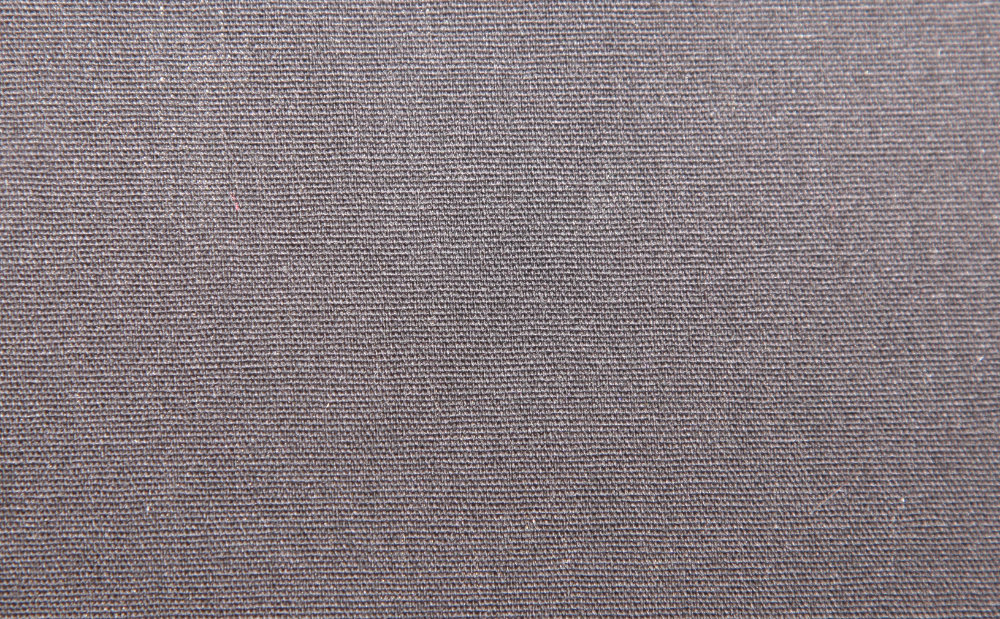
Because of the method of construction, woven fabrics typically don’t have any stretch cross-grain or with the grain (length of fabric). If they do, it’s usually from added stretchy yarns such as lycra or spandex. Sometimes there is a little bit of give on the cross-grain, but typically not. Woven fabric appears to “Stretch” along the bias grain though. That is a 45-degree angle between the length grain and the cross grain. Any pieces cut along the bias will stretch out or deform.
Most woven fabrics will unravel if the edge isn’t treated. Some are worse than others which probably has more to do with the type of yarns and the tightness of the weave.
If you snip woven fabric on the selvage edge and rip it, it will rip on the cross-grain. More precisely, it will rip along the weft yarns. If the fabric isn’t great quality, this could end up kind of crooked. 🙂
Some fabrics have a pattern woven into them using different color yarns. If you have a stripe that is made with the yarns, rather than printed, you can be pretty sure that the stripe is on grain. If it’s printed, it could be a little off if they didn’t quite get everything lined up.
While printed fabrics have a pretty obvious right (correct) and wrong side, fabrics that aren’t printed may be a little more difficult to discern correct side from wrong side. And in some fabrics, like Jacquards, you might like both sides, even though one is technically the correct side.
Common Woven Fabrics
You’ll run into woven fabrics like broadcloth, shirting, suiting, twill, corduroy, velvet, satin, chiffon, georgette, poplin, china silk (which isn’t silk) and a whole bunch more.
A twill weave has visible lines that go diagonal in the fabric from the weave. Twill doesn’t specifically have a weight. So you might find a shirt-weight twill or a pant-weight twill. Denim is typically a twill weave.
Velvet has a pile. This means that the fibers have been looped and cut to make the fabric “fuzzy”. Velvet also has “nap”. Which means it will look different depending on how it hangs. That’s important to keep in mind when laying out your pattern pieces.
Corduroy also has pile. But typically it’s formed in rows, usually with the length of the fabric. It’s classified by the width of the row of fuzzy stuff. This is called wale. So, a “wide wale” corduroy will have wider or thicker rows of the fuzzy pile.
China silk isn’t silk. It’s often polyester. And it actually falls into a category of fabrics that are typically used for lining. It can have a slightly shiny appearance and will often be semi-transparent.
Satin has a shiny side and a not shiny side. It can be different weights. Charmeuse satin is pretty lightweight and slippery whereas bridal satin is less drapey and stiffer. This makes it easier to work with.
Broadcloth is a pretty “normal” woven fabric, and often cotton or cotton/poly blend. It’s easy to work with like quilting cotton (they are similar in weave).
Shirting is a woven fabric that works well for dress shirts.
Suiting works well for suits, slacks, and trousers.
Why don’t we have a “Panting?”
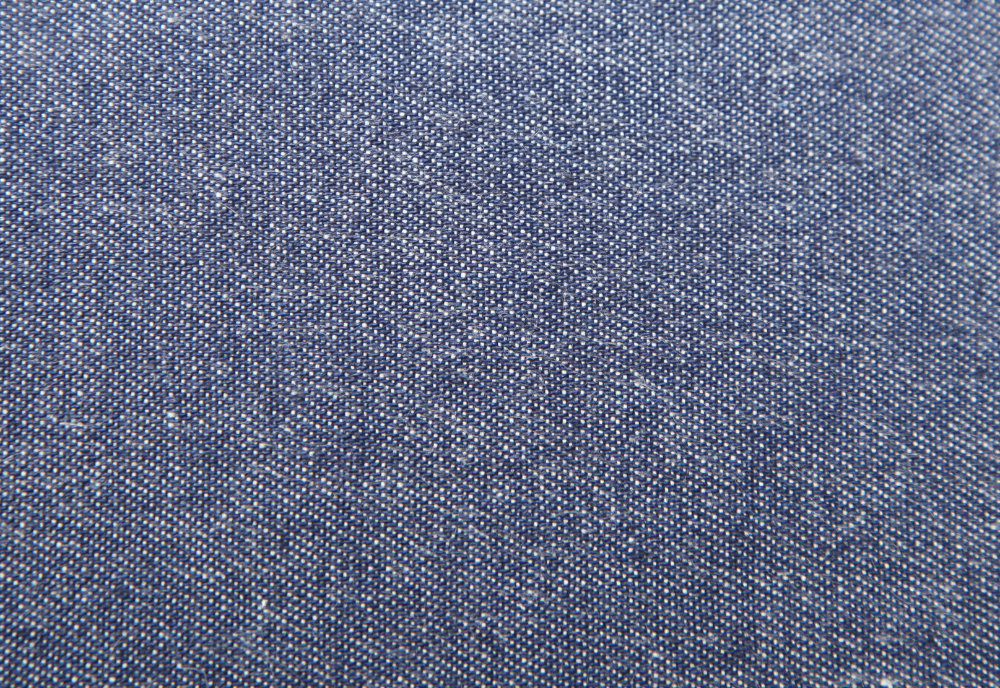
Denim Fabric (Twill Weave)
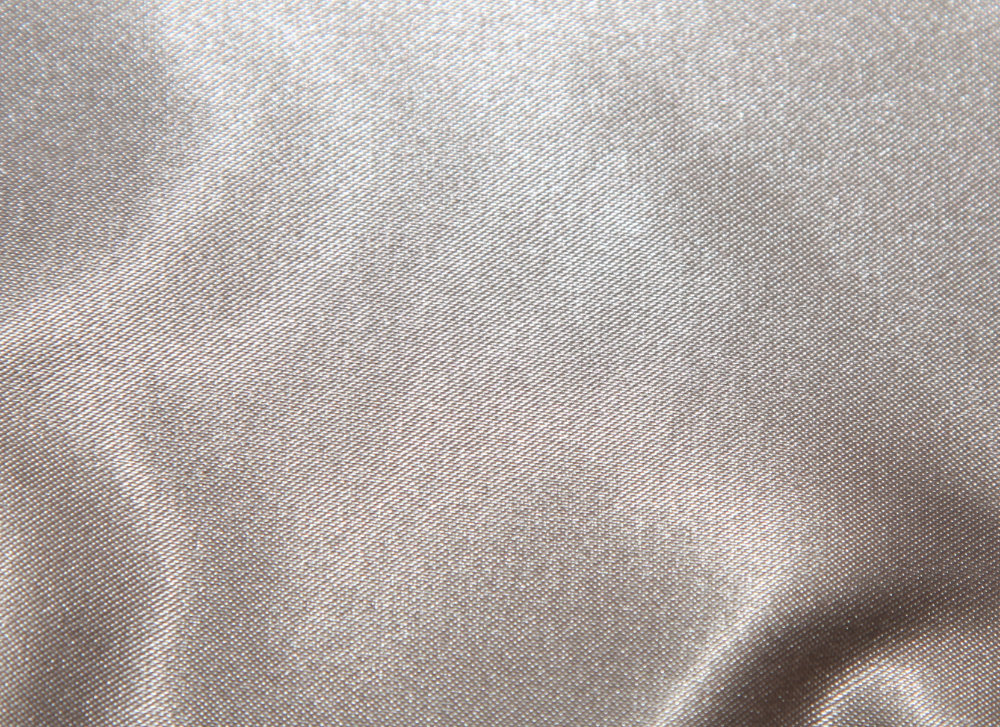
Satin Fabric Weave
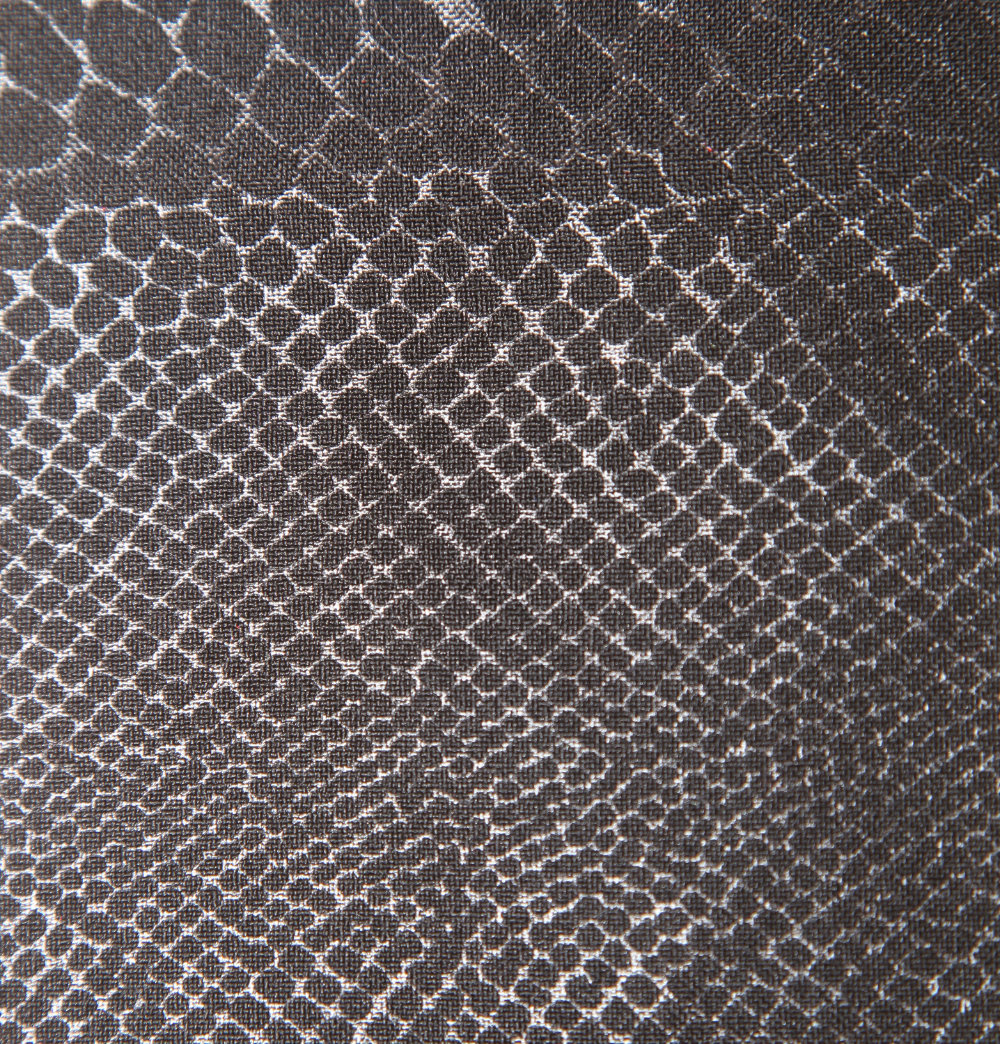
Embossed Poplin Fabric
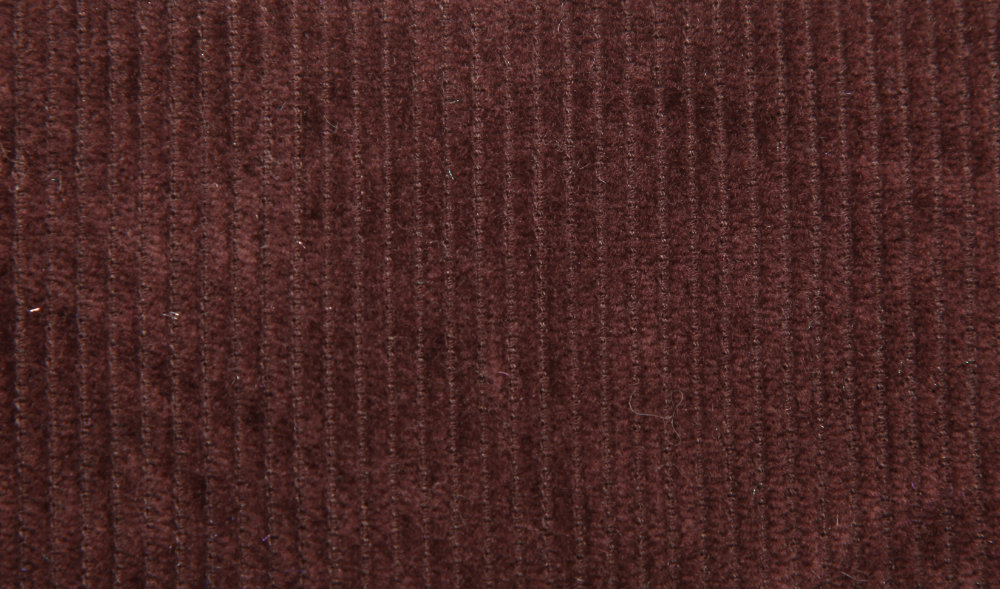
Corduroy Fabric
Chiffon and Georgette are sheer (see-through) fabrics that are lightweight and flowy. Not suitable for the beginner sewist. These fabrics will test your patience.
Best Uses for Woven Fabrics
For stiffer fabrics like suiting, shirting, twill, and bridal satin, structured garments like fitted jackets, shirts, and non-flowy pants like structured trousers, jeans or cargo pants (depending on the fabric weight). Suiting can be lined and interfaced to add to the structure for jackets while providing a more fluid pant.
Fabrics like charmeuse satin, chiffon and georgette are more suitable for non-structured garments like billowy skirts, drapey shirts, and light breezy shawls or overcoats.
If you are sewing with a woven fabric, stay away from fitted clothes that are meant to hug the body and still allow it to move (like a leotard). You can make corsets with wovens, even though they are meant to hug the body, the boning in the corset isn’t really meant to allow the body to move. Save your airy fabrics for your gathered skirts and billowy sleeve flounces.
Garments that are made out of woven fabrics will typically have more ease put into the pattern. Ease refers to the extra room or space in a garment to allow for movement. For example, your hips might measure 36″, but the garment finished size might be 39″. That gives 3″ of wearing ease.
Knits
A knit fabric is literally a fabric made from the technique of knitting. Imagine grandma with the two knitting needles but in a MUCH larger scale and much tinier yarns (sometimes).
There are several types of knit fabrics. Each type has its own properties. Some knit fabrics will unravel on the cut edge. But many do not.
Knits, like wovens, have a selvage edge. On a lot of knits, this edge might distort the lay of the fabric. Usually, it’s recommended to cut it off so that the fabric lies flat for cutting.
Most knits will stretch cross-grain (selvage to selvage). Some will only stretch in the length. Not all knits stretch in both directions. If they do, the fabric is considered 4-way stretch. Your pattern will call for a 4-way stretch knit if it is needed. Otherwise, a typical 2-way is needed. Sometimes, the lengthwise stretch is greater than the cross stretch. And some patterns call for the piece to be placed “on the direction of greatest stretch” rather than “on the grainline”. This is important to note cause it could affect the fit or function of your garment.
Patterns calling for knits will typically specify the amount of stretch required. If 50% stretch is needed, that means a 4″ piece of fabric will stretch to be at least 2″ longer.
Some patterns call for wovens or “stable knits”. A stable knit fabric doesn’t stretch much. A good rule of thumb would be less than 20% stretch. Some knits stretch so little that they are hard to tell they are knits without looking at the actual yarn patterns.
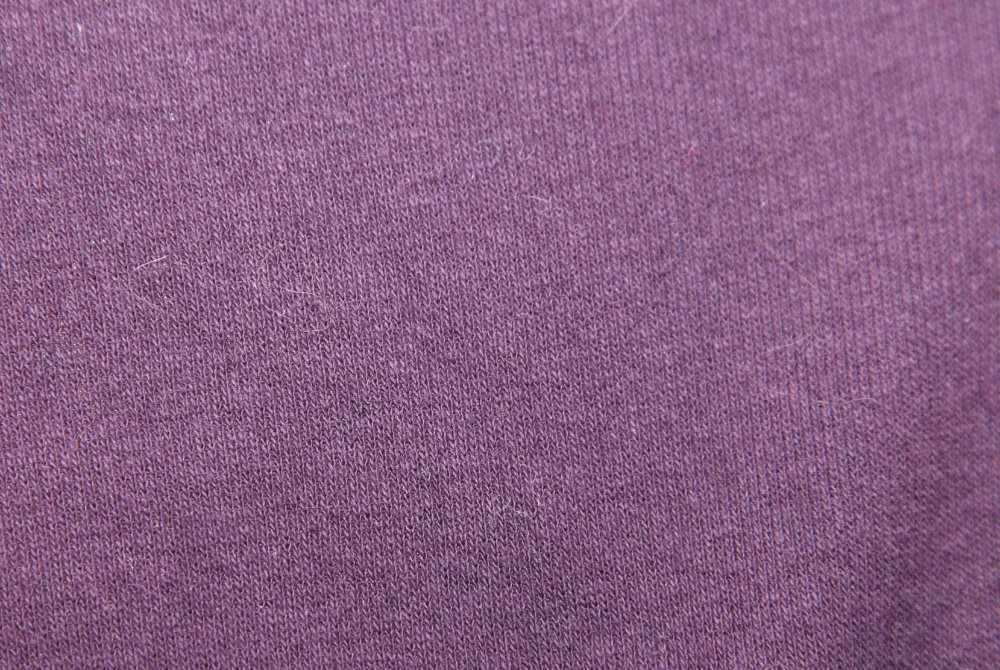
Knits typically have a V formation of yarns on the correct side when you look really close. The back side will have little lines. However, some knits will have V’s on both sides from the pattern of knitting. Take a ribbed knit, it will look very similar on both sides. But a typical t-shirt fabric will have Vs on the front and not the back.
Knits could be printed. But they can also have the pattern knitted into them with the yarns.
Common Knit Fabrics
Some common knit fabrics you’ll see are jersey, double knit, interlock, ribbed, fleece, ITY, and tricot.
Most classifiable knits are weft knits. The following are weft knits.
Probably the most common you will find is jersey knit. It’s a standard knit with a right and wrong side (correct and wrong side). T-shirt fabric is typically jersey knit.
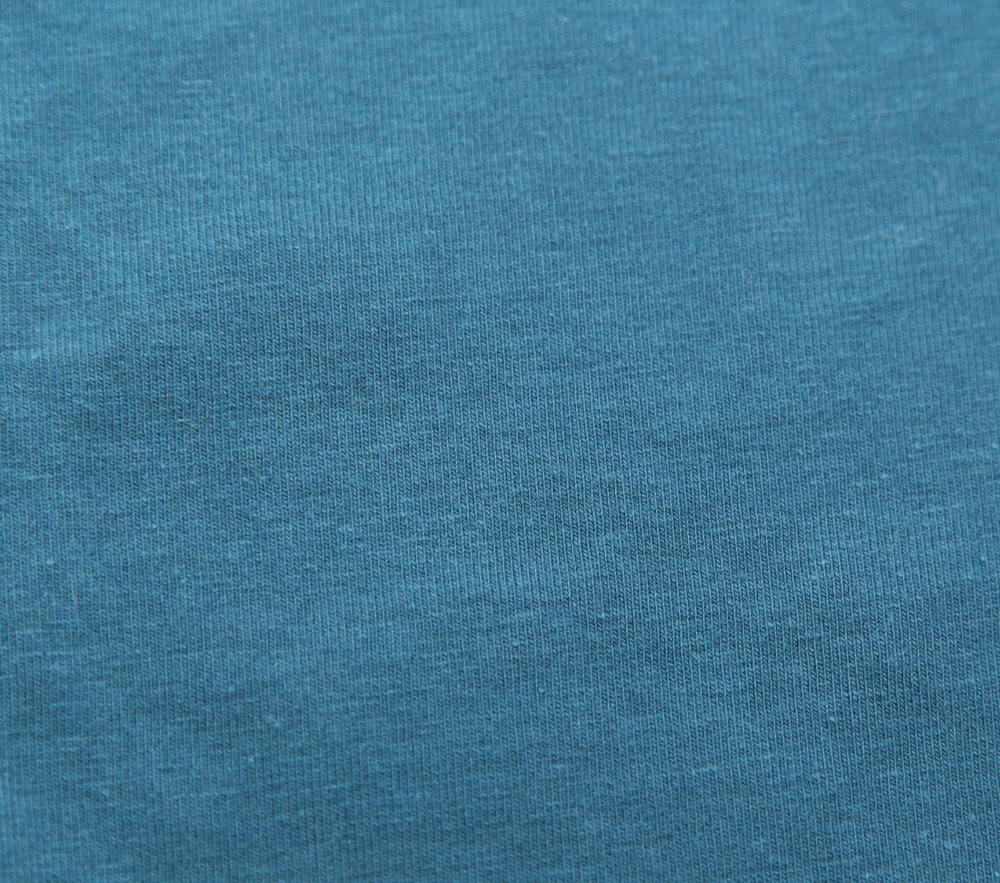
Front Detail of Jersey Knit
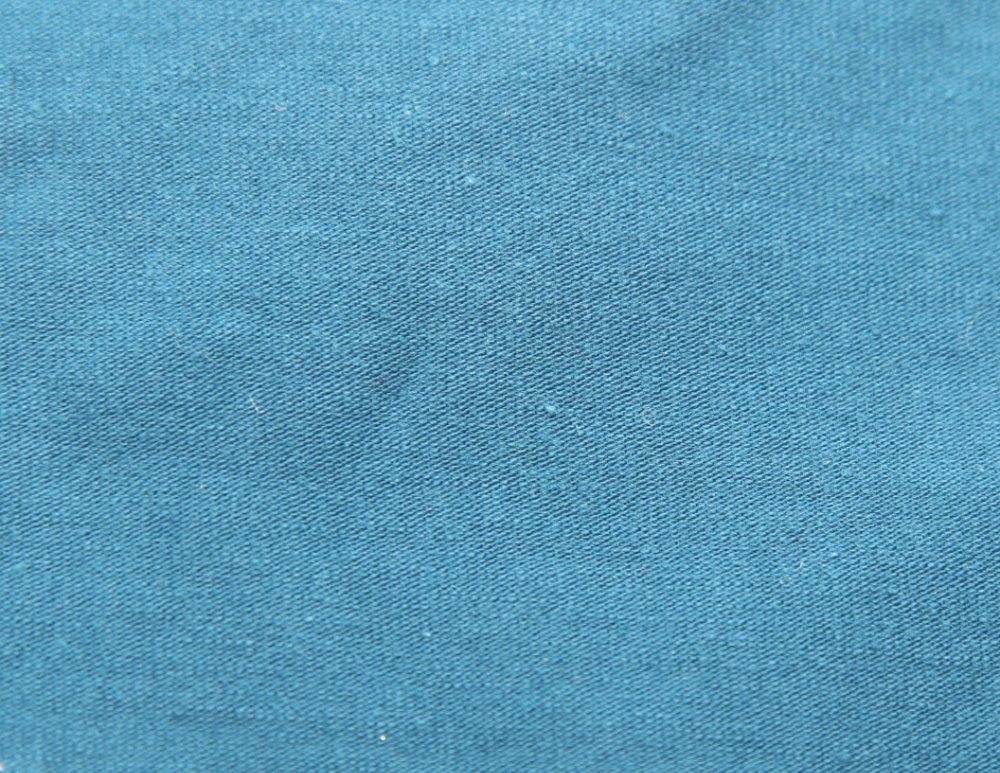
Back Detail of Jersey Knit
Double Knit fabric uses two sets of needles and more yarns than a single knit. It ends up with two faces (two correct sides). Though, it could have a decorative stitch on one side and only fine ribs on the other. It’s usually pretty stable and better for more structured garments, and garments with more ease because it does not stretch that much. Cut edges don’t curl.
Interlock fabric is knitted in a way that makes the fabric not have a correct or wrong side. In that, it is similar to the double knit. It will have more stretch in the cross-grain and often has no stretch in the length grain.
ITY stands for Interlock Twist Yarn. It has to do with a twist they put into the yarn when knitting it. This results in a natural elasticity and a soft feel. You can find these fabrics often with a variety of prints. It is a type of Interlock knit fabric.
Ribbed knits have obvious lengthwise ribs of knit stitches (the v-formed stitches). It’s reversible.
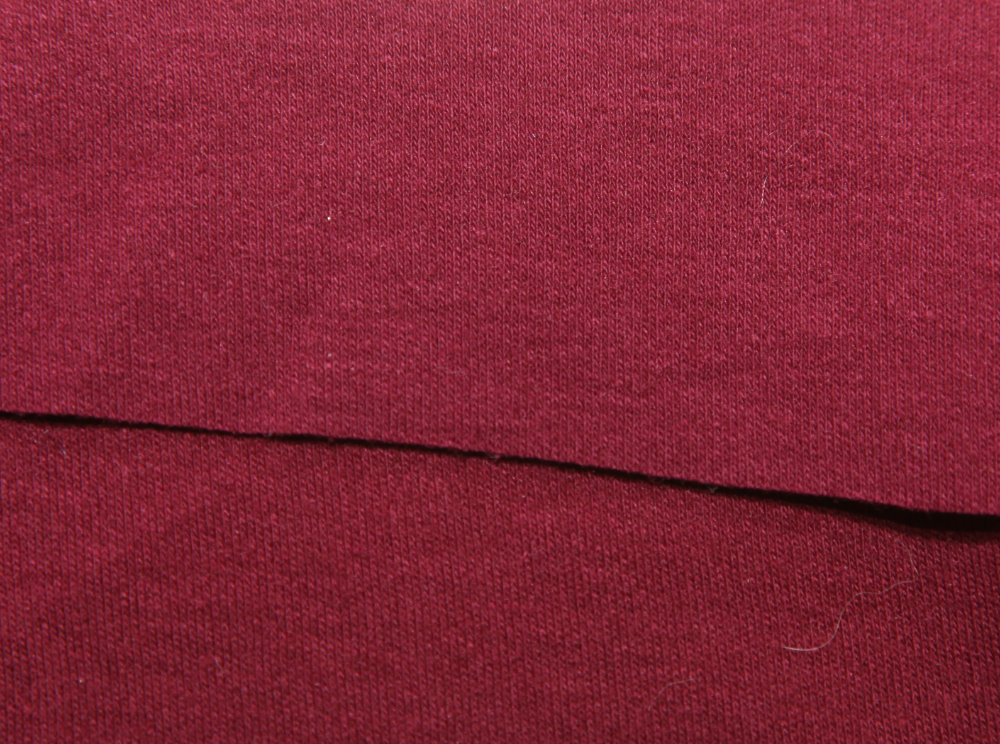
Double Knit Fabric
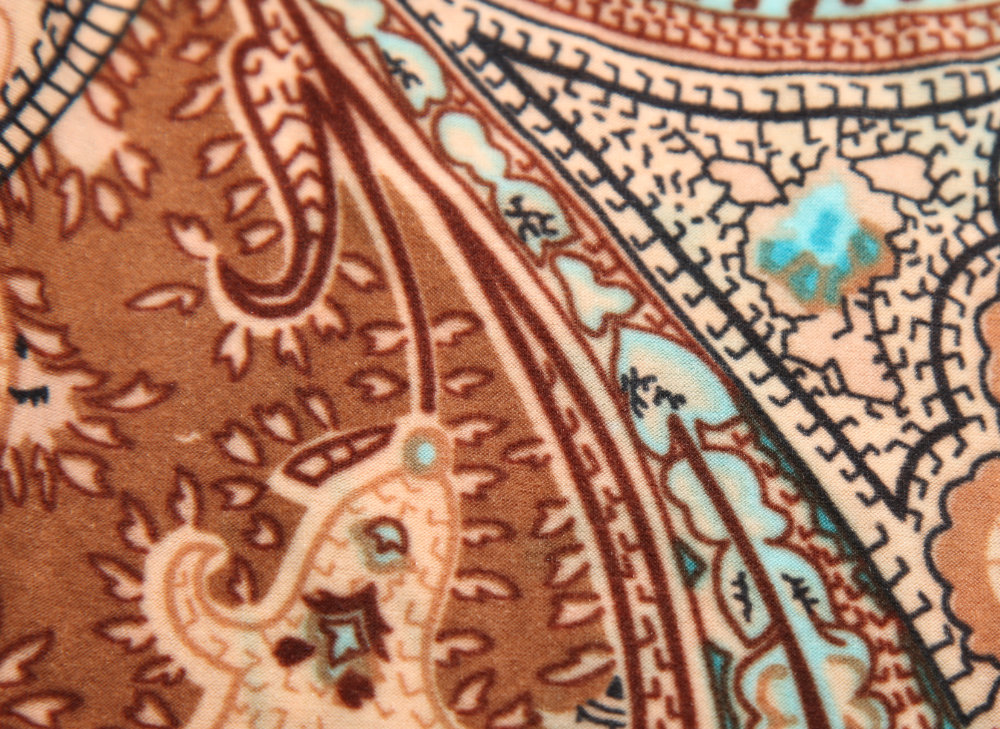
ITY Knit Fabric Detail (Printed)
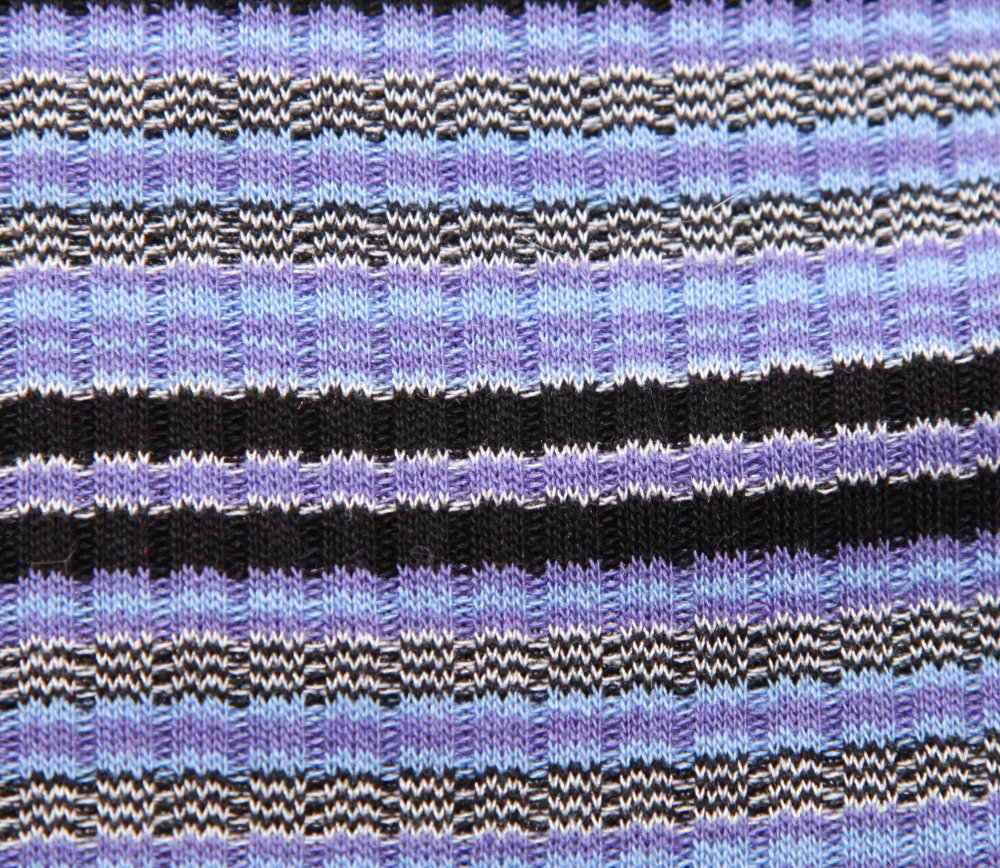
Ribbed Knit Detail
Fleece knits are all standard knits but have different levels of bulk and fuzz. 🙂 Fleece is a pretty stable knit fabric with minimal stretch and has at least one fuzzy side.
Warp knits aren’t as easily classifiable because the machines used to produce them can do a wide variety of things and therefore there is more variety in what they look and act like.
Tricot is actually a warp knit fabric and will have more stretch in the length than crosswise. Tricot is typically used for linings and lingerie.
Best Uses for Knit Fabrics
Some knits (such as the stable knits mentioned above) can be substituted for woven fabrics. And the reality is, you can make any pattern out of a knit fabric, even if it calls for a woven. It will … fit around your body. However, it might hang funny, or be too loose. This is because of the natural ease the stretch of knit fabrics give. A typical pattern for knit fabric will have less ease or even negative ease than a pattern for a woven fabric. This means that armholes will be smaller, necklines could be smaller and require stabilization with stretch.
If you want to make activewear like yoga pants, bike shorts, sports bras, fitted t-shirts or leotards, you need a knit fabric.
Knits can be made into skirts and pants as well. Depending on the style you are going for, you can have very fitted pants in one area of the leg, and billowy bits in another. Unless the knit is super stable, it will likely have good drape.
Sweaters, sweatshirts, 1/2 or 1/4 zip pullover shirts are all best made with knit fabrics.
It’s always best to look at the pattern and consider the use of the fabric when choosing your knit. Really form-fitted pants probably should have a 4-way stretch knit. Though, a more loose pair of warm-up pants or shorts could probably get away with a 2-way stretch knit.
Other Fabrics
There are other methods of fabric construction such as bonding (non-woven), felting, or crochet.
The most common “other” fabrics you will run into for garment construction are non-woven interfacing (if you can call that a fabric) or a lace or mesh that isn’t knit or woven. Some laces are actually crocheted or constructed in a manner similar to crochet.
These fabrics may have some give in one direction or the other but are usually not stretchy unless some kind of lycra has been added.
Often, these fabrics will behave similarly to woven fabrics when sewing, except they won’t fray.
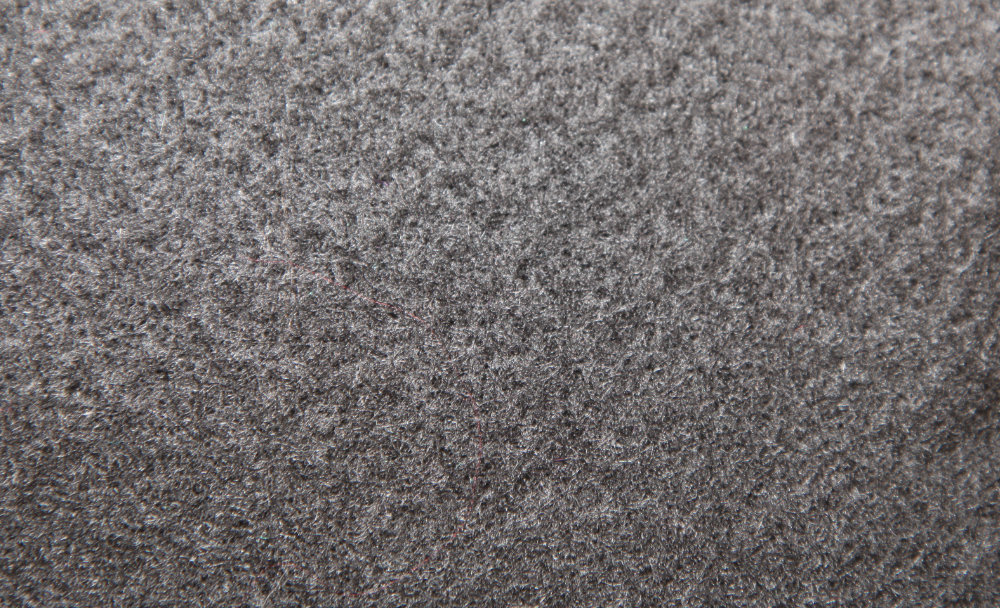
Felt – Fibers are mashed together not woven or Knit.
Basic Fibers
Fibers, not to be confused with fabric manufacturing methodologies, refers to the type of material or material source that the fabric is made out of. Fabric can be knit silk or woven silk, polyester knit or woven knit.
Natural
There are a lot of natural fibers available today. Here are the most common.
Plant Fibers
Cotton, bamboo, and linen are made from plant fibers. They vary in softness depending on how they are processed.
Cotton is probably the most affordable. But sometimes it’s harder to find in a pure form (if you want it pure) because it’s often blended with other fibers to get certain characteristics. Cotton can wrinkle and shrink a lot. Take shrinkage into account when buying yardage. And when considering it for clothes, know that it might need ironing.
Linen is a favorite for summer garments. It is known for wrinkling. But folks that wear it love it. It’s breathable so it makes good suits and pants as well as nice tops or skirts.
Bamboo is a very renewable resource. The fabric is harder to find and more pricey than cotton or synthetic substitutes. Often rayon and bamboo have similar qualities – softness.
Semi-Synthetic/Natural Plant Fiber
Rayon is weird in that it is technically made from a plant. Or, rather the cellulose of a plant. In some areas, you will see it called “Viscose”, or even “Rayon/Viscose”. So, the source fiber is cellulose, but it’s processed enough to be considered not 100% natural fiber.
Rayon has been made into a variety of fabrics and can be quite soft. In fact in some cases it can be a good substitute for silk. It’s more delicate than cotton.
Animal Sourced Fibers
Silk and Wool are made from animals.
Silk comes from silkworms. Many practicing vegans avoid silk. Silk has increased in price in the past decade or so due to something that wiped out the silkworm population in China. I have loved silk, and for some things, it’s really a good option. It’s fairly resilient. Often it can be washed. And it’s surprisingly heat resistant (so ironing is not a problem.) But I totally understand not buying it for ethical reasons.
Wool doesn’t require the destruction of the animal to make and is processed after shearing the animal, which is actually a good thing for the animal to go through. There are other animals like alpacas and llamas that can also have their excess … wool be made into fibers for fabrics. The coat of the animal is basically shaved off, and then the small hairs are spun into long yarns. I mean, technically you could brush your cat out and collect enough fur to spin into yarn if you were so inclined. Wool can be subject to extreme shrinking if not cared for properly. And, since it is animal-based, some folks are allergic to it.
Man-Made
There are some common man-made (synthetic) fibers as well. Synthetic fabrics got a bad rep in the ’70s (think of old 70’s polyester suits). Largely those primitive fabrics didn’t look as good as natural fabrics, and they didn’t breathe very well. They have come a long way though. Many of the high-tech fabrics of today are actually synthetic. This has allowed manufactures to increase breathability, moisture-wicking, fiber strength, abrasion resistance, and drying abilities. Here’s some of the most common.
Polyester is used to make fleece, fur, activewear, as well as suiting, shirting, lining, and satin. Some top branded synthetic manufactures use this as a basis for flame resistant or higher strength fabric. Also is blended with cotton or other natural fibers to increase wrinkle-resistance or other desirable qualities.
Nylon is also a man-made fiber. Nylon has strength and flexibility, can be water-resistant or help screen wind (Windbreaker), also has resistance to abrasion and can be quick drying. Some common swimwear fabrics use Nylon and combine it with Spandex for more stretch. But nylon is also used for jacket linings or outers.
Spandex is a polyurethane-based fabric that is really stretchy. It is blended with both natural and synthetic fibers in both knit and woven fabrics to create fabrics that have better recovery when stretched. Recovery means that they go back to their original shape (or size) after stretching.
Acrylic is another common synthetic fiber that is a common substitute for wool. It’s good for folks that have allergies to wool.
Synthetic Fur, Leather, and Suede are options to replace animal sources of these fabrics.
Synthetic fur is available in many colors, lengths, levels of shag and realistic look or feel. Most furs have a synthetic fur fiber that is attached to some kind of backing (also synthetic). The backing can be knit or woven.
Synthetic leather is typically made from polyurethane or polyvinyl chloride and has a knit or woven back. You might see “PU Leather” or “PVC Leather” listed on websites.
Synthetic suede is typically made from a nylon or polyester blend and is brushed to be softer.
Neoprene is a synthetic rubber. It’s added to other fabrics for water resistance and stretch. It’s a strong, resilient substitute for natural rubber (which is from a tree).
Conclusion
There are a lot of choices out there when you are considering making garments. While there are no hard and fast rules regarding fabric types, there are some definite guidelines. You want enough stretch for garments that need stretch, and you want enough structure for garments that need structure.
Fiber doesn’t dictate what the fabric can or can’t be used for, but it can dictate how you will need to care for the garment or how the garment can be used.
The type of fabric (knit or woven) typically indicates how the fabric will behave (stretch or not). But with new fibers like spandex available, woven fabrics get to be stretchy. And some knits aren’t as stretchy as others.
A good thing to try is to get a feel for the fabric before making decisions. If you have a fabric store you can go to, walk the aisles, feel the fabric, test the drape or stretch on them. You can often see the fiber content and “type” of fabric on the end of the bolt. You can use this knowledge to also buy online fabrics. Many online stores sell swatches. Though it’s hard to get a good feel for drape from a 2″ x 4″ piece of fabric. But it is better than nothing.
Making the right fabric choice is important for your garment to turn out or be wearable. As you make more garments, you’ll get a better feel for what works and what doesn’t. And eventually, you may even learn some ways to break the rules. 🙂
Let me know what your favorite fabric to sew within the comments below.
Learn to sew. Go at your own pace. Learn helpful techniques and tips to make sewing more enjoyable.

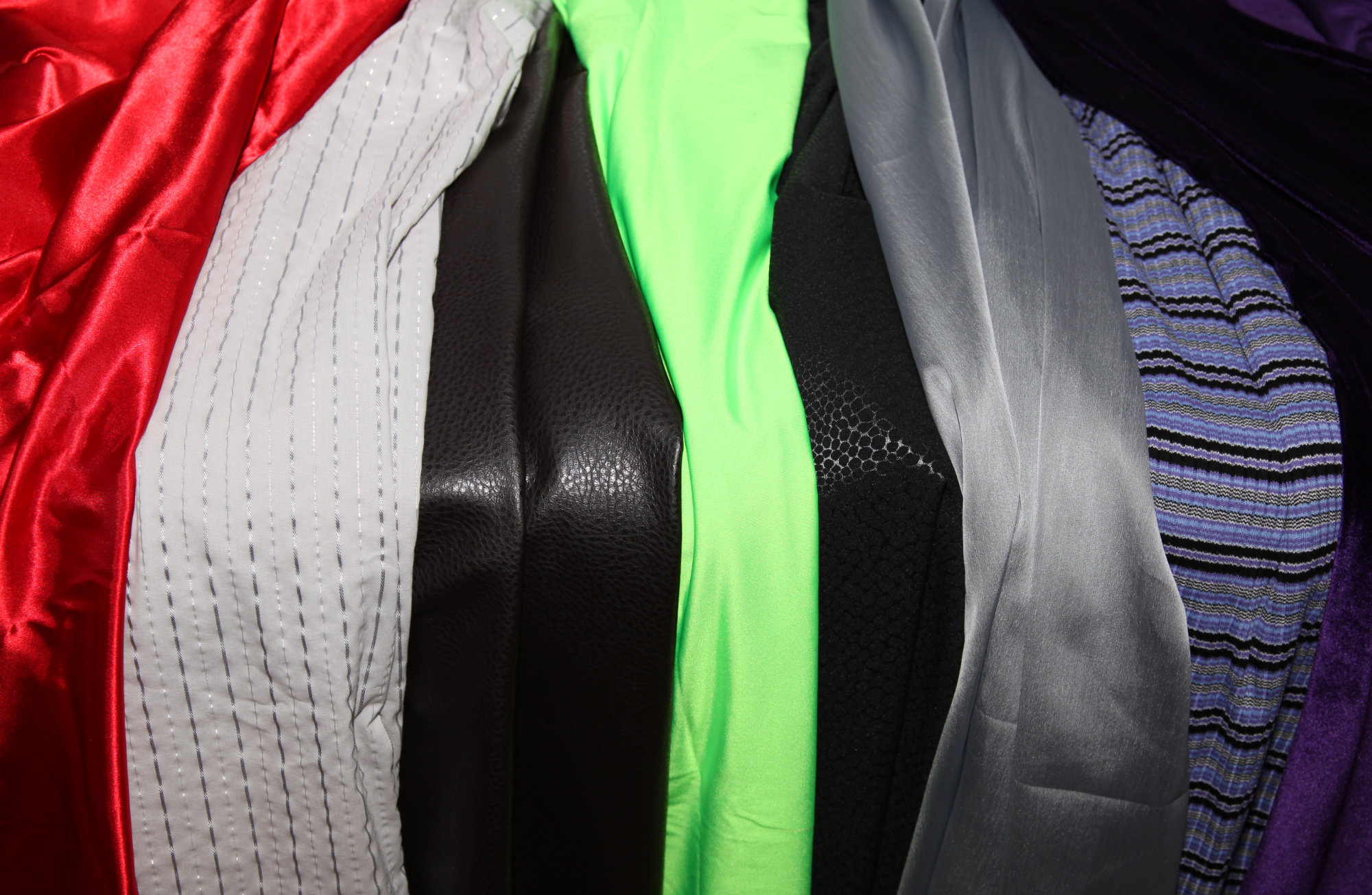
0 Comments